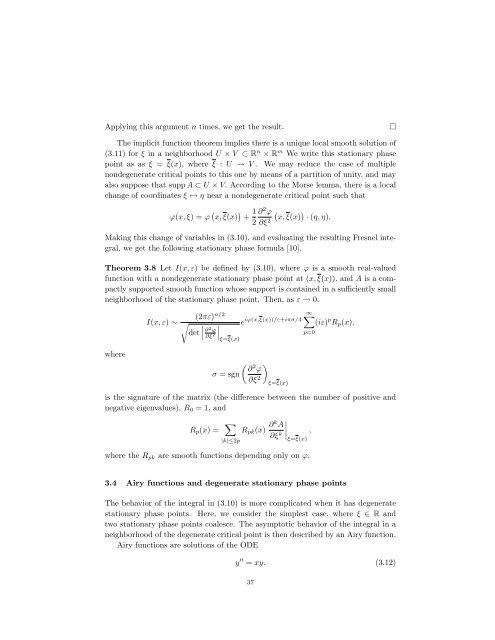Asymptotic Analysis and Singular Perturbation Theory
Asymptotic Analysis and Singular Perturbation Theory
Asymptotic Analysis and Singular Perturbation Theory
You also want an ePaper? Increase the reach of your titles
YUMPU automatically turns print PDFs into web optimized ePapers that Google loves.
Applying this argument n times, we get the result. <br />
The implicit function theorem implies there is a unique local smooth solution of<br />
(3.11) for ξ in a neighborhood U × V ⊂ R n × R m We write this stationary phase<br />
point as as ξ = ξ(x), where ξ : U → V . We may reduce the case of multiple<br />
nondegenerate critical points to this one by means of a partition of unity, <strong>and</strong> may<br />
also suppose that supp A ⊂ U × V. According to the Morse lemma, there is a local<br />
change of coordinates ξ ↦→ η near a nondegenerate critical point such that<br />
ϕ(x, ξ) = ϕ x, ξ(x) + 1 ∂<br />
2<br />
2ϕ ∂ξ2 <br />
x, ξ(x) · (η, η).<br />
Making this change of variables in (3.10), <strong>and</strong> evaluating the resulting Fresnel integral,<br />
we get the following stationary phase formula [10].<br />
Theorem 3.8 Let I(x, ε) be defined by (3.10), where ϕ is a smooth real-valued<br />
function with a nondegenerate stationary phase point at (x, ξ(x)), <strong>and</strong> A is a compactly<br />
supported smooth function whose support is contained in a sufficiently small<br />
neighborhood of the stationary phase point. Then, as ε → 0,<br />
where<br />
(2πε)<br />
I(x, ε) ∼<br />
n/2<br />
<br />
<br />
det<br />
∂2ϕ ∂ξ2 <br />
ξ=ξ(x)<br />
σ = sgn<br />
e iϕ(x,ξ(x))/ε+iπσ/4<br />
2 ∂ ϕ<br />
∂ξ2 <br />
ξ=ξ(x)<br />
∞<br />
(iε) p Rp(x),<br />
is the signature of the matrix (the difference between the number of positive <strong>and</strong><br />
negative eigenvalues), R0 = 1, <strong>and</strong><br />
Rp(x) = <br />
<br />
<br />
,<br />
|k|≤2p<br />
Rpk(x) ∂k A<br />
∂ξ k<br />
ξ=ξ(x)<br />
where the Rpk are smooth functions depending only on ϕ.<br />
3.4 Airy functions <strong>and</strong> degenerate stationary phase points<br />
The behavior of the integral in (3.10) is more complicated when it has degenerate<br />
stationary phase points. Here, we consider the simplest case, where ξ ∈ R <strong>and</strong><br />
two stationary phase points coalesce. The asymptotic behavior of the integral in a<br />
neighborhood of the degenerate critical point is then described by an Airy function.<br />
Airy functions are solutions of the ODE<br />
p=0<br />
y ′′ = xy. (3.12)<br />
37
















